Uruguay and Colombia’s form had dipped over recent months.
Neither side has consistently performed well since they faced each other in the Copa América semi-final.
Uruguay had failed to win any of their last four fixtures.
Colombia had won two of their previous four matches.
However, a loss against 10-man Bolivia and a draw against Peru meant they’d yet to find their best form since reaching the Copa América final.
Uruguay sat in fourth place, three points behind Colombia who were second in the World Cup Qualification table.
Not only was a win vital for both sides to push themselves closer to World Cup qualification, but after the hostile scenes amongst both sets of players and supporters in the Copa América semi-final, both teams would be keen to get one over on each other.
The match saw two dramatic late goals.
Colombia thought they had equalised to share the points.
Yet just minutes later, in the 11th minute of stoppage time, Manchester United’s Manuel Ugarte scored the winner to send Uruguay above La Sele.
Despite there being an extraordinary finish to the game, it was a match where Uruguay outplayed La Tricolor.
Marcelo Bielsa’s men found the solutions that helped them overcome Colombia’s narrow setup.
This tactical analysis will look to dissect these solutions and highlight Colombia’s weaknesses.
Uruguay Vs Colombia Lineups
Uruguay Formation
Bielsa’s side set up in their traditional 4-2-3-1 formation.
Sergio Rochet started as keeper.
The back four consisted of Nahitan Nández, José María Giménez, Mathías Olivera and Marcelo Saracchi.
Real Madrid’s Fede Valverde was placed
in midfield beside Tottenham’s Rodrigo Bentancur.
Facundo Pellestri, Rodrigo Aguirre, and Maximiliano Araújo were the attacking support to Liverpool’s centre forward Darwin Núñez.
Colombia Formation
Colombia decided to take up a far more narrow formation, lining up in a 4-3-1-2.
Goalkeeper Camilo Vargas was partnered with a back four of Johan Mojica, Jhon Lucumí, Davinson Sánchez and Daniel Muñoz.
At the point of the diamond, a midfield four consisted of Jhon Arias, Juan Portilla, Richard Ríos, and Juan Fernando Quintero.
Premier League duo Luis Díaz and Jhon Durán led the attack as Colombia’s two centre-forwards.
Uruguay Vs Colombia Build Up
Both sides insisted on playing through the thirds and used different methods to overcome their opponents’ pressing traps.
Colombia were relatively successful when playing out from the back.
Uruguay aimed to force play away from the middle of the pitch, where Colombia normally had a numerical advantage.
When Uruguay pressed intensely, this worked a treat.
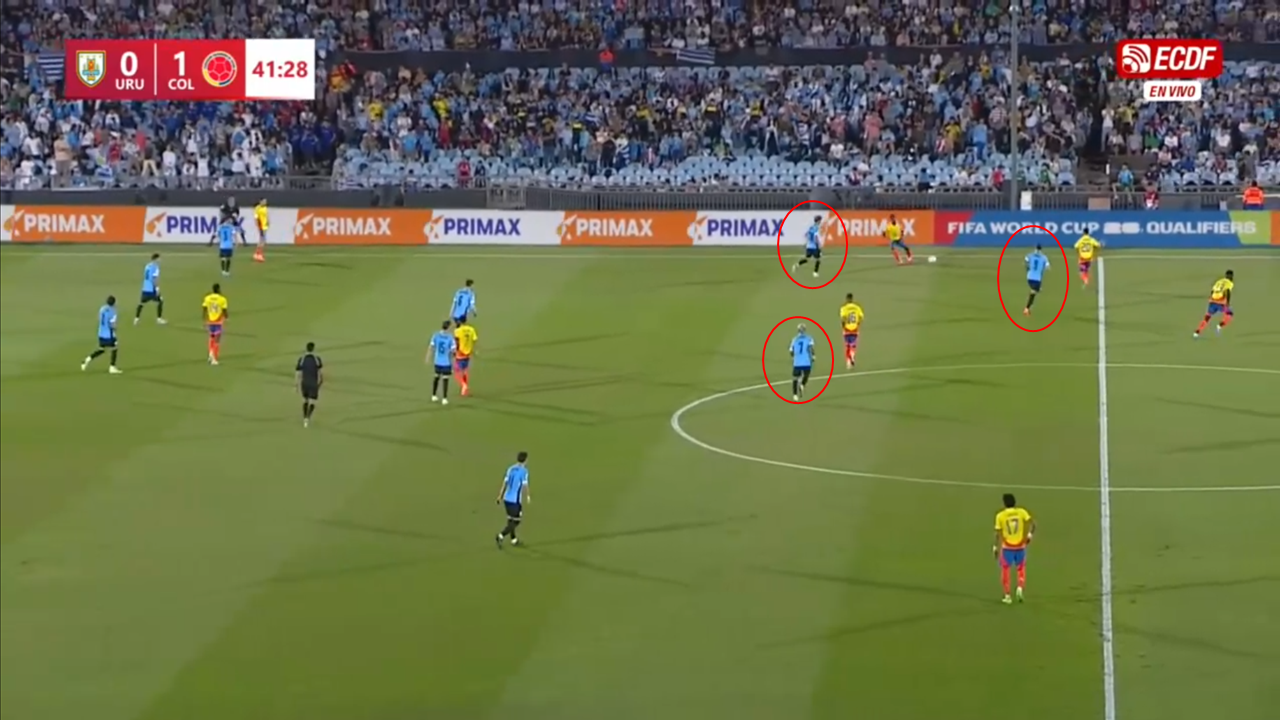
In this situation, we see Núñez forcing the opposition’s centre-back outside and his supporting teammates.
This leaves the player on the ball with limited options.
When Uruguay had forced their opponents into these situations they would either crowd them out as they played forward down the wing or force them to kick long.
However, Colombia overcame this press on multiple occasions using clever rotations.
One of the most used interchanges was between Mojica and Arias.
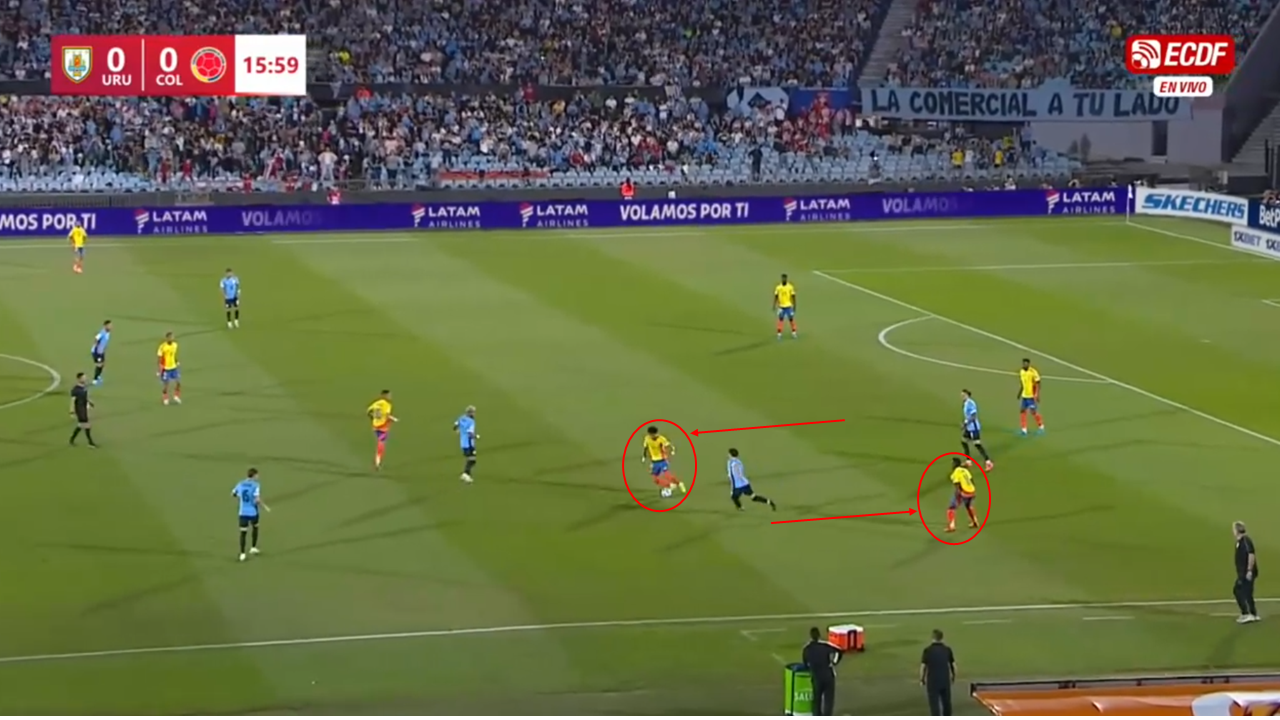
Arias would often drop into the left-back position as Mojica looked to wander inside.
This confused Pellestri, who didn’t know who to follow.
Colombia often used the idea of one midfielder dropping deep to receive the ball and another remaining high.
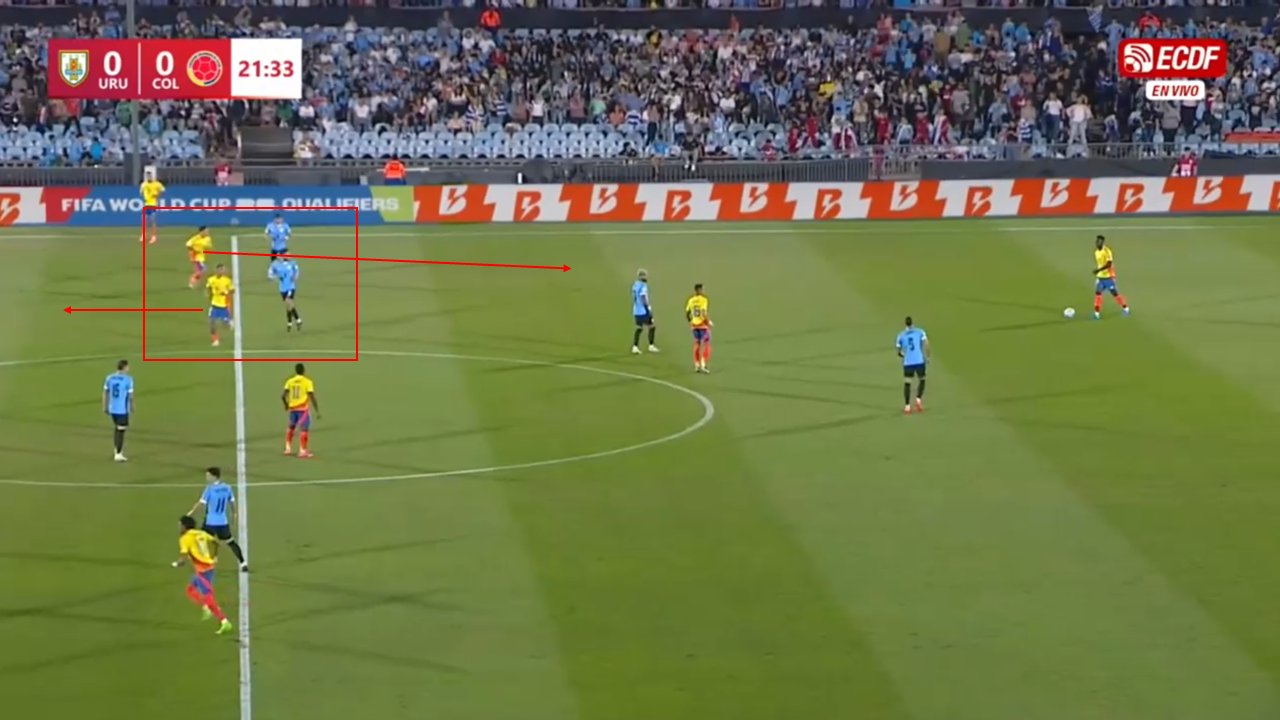
If the player who dropped deepest to receive the ball wasn’t an option, they would quickly change to one of the midfielders who were positioned higher up the pitch.
Having previously asked for the ball at his feet, Rios moved towards River Plate’s Quintero drops into a pocket vacated by his teammate in an attempt to receive the ball unmarked.
Uruguay displayed a masterclass in beating a high press.
Along with the back four, Bentacuar would drop deep to provide an option to progress play forward.
Colombia had two tactics when pressing.
The first was to ensure that Uruguay couldn’t easily switch the ball and take advantage of their narrow formation.
This rarely worked, as Uruguay’s centre-backs were incredibly comfortable playing a variation of chipped and curved passes around the Colombian attacker, who would attempt to cut off the full-back.
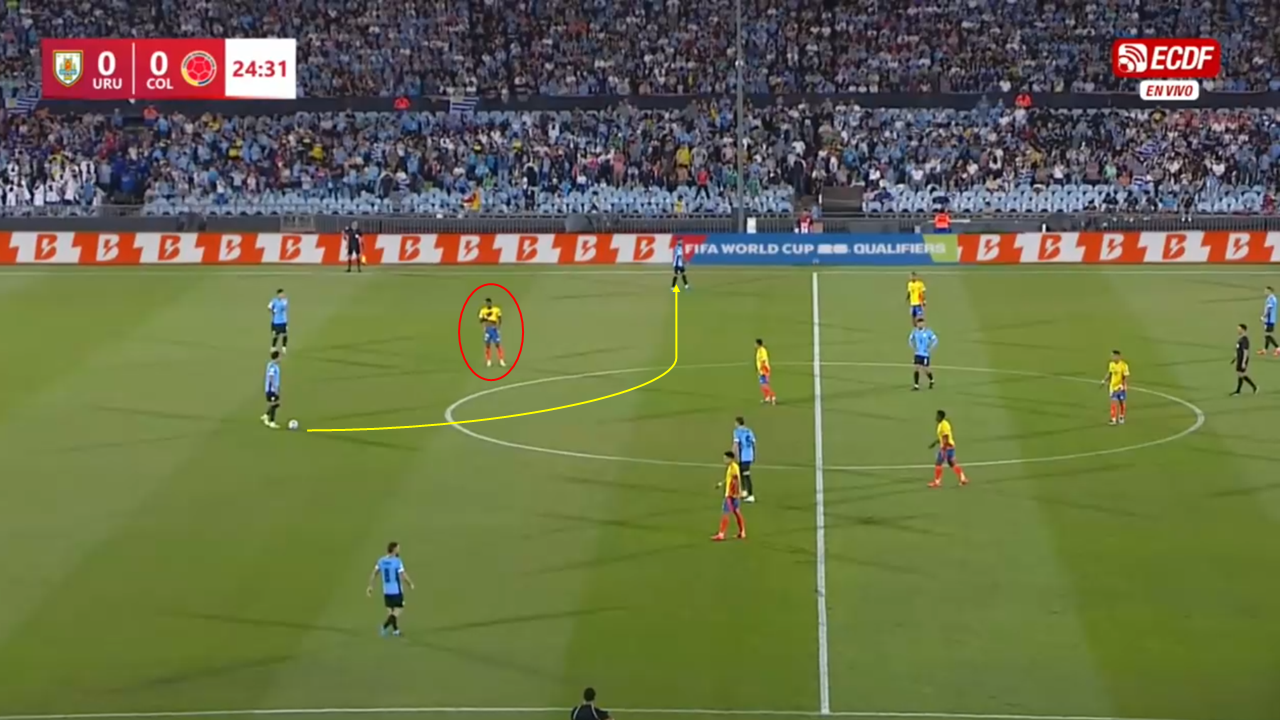
Here, Aston Villa‘s Durán attempts to take up a position that discourages Uruguay from playing to the full-back on the far side.
However, Giménez plays an intelligent pass around the striker to find his teammate.
The second tactic was to press intensely man to man as the ball was played into midfield.
This was a grave error as Uruguay used one of Bielsa’s most trusted weapons, the third man.
Using the third-man run, Uruguay easily alleviated the pressure and progressed the ball quickly and dangerously, breaking Colombia’s defensive lines.
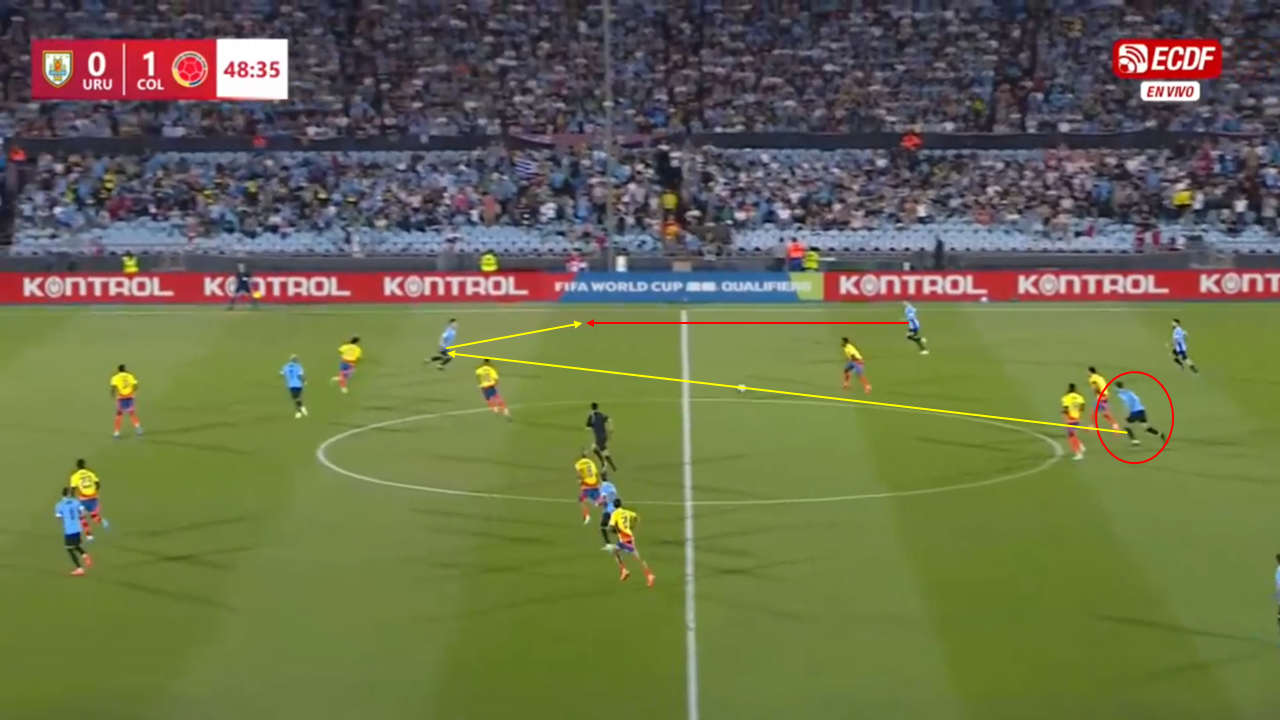
In this situation, Bentacuar has the ball deep in his own half.
He plays the ball forward to Pellestri, who can then find Nandèz, putting Uruguay in a position to break forward quickly.
Channels Of Attack
Colombia and Uruguay used contrasting methods to penetrate the final third.
Uruguay used the available width provided by Colombia’s narrow setup.
This resulted in Uruguay having 24 crosses instead of their opposition’s four crosses.
However, Colombia defended these crosses efficiently, as Uruguay only saw 8% of their crosses find the intended target.
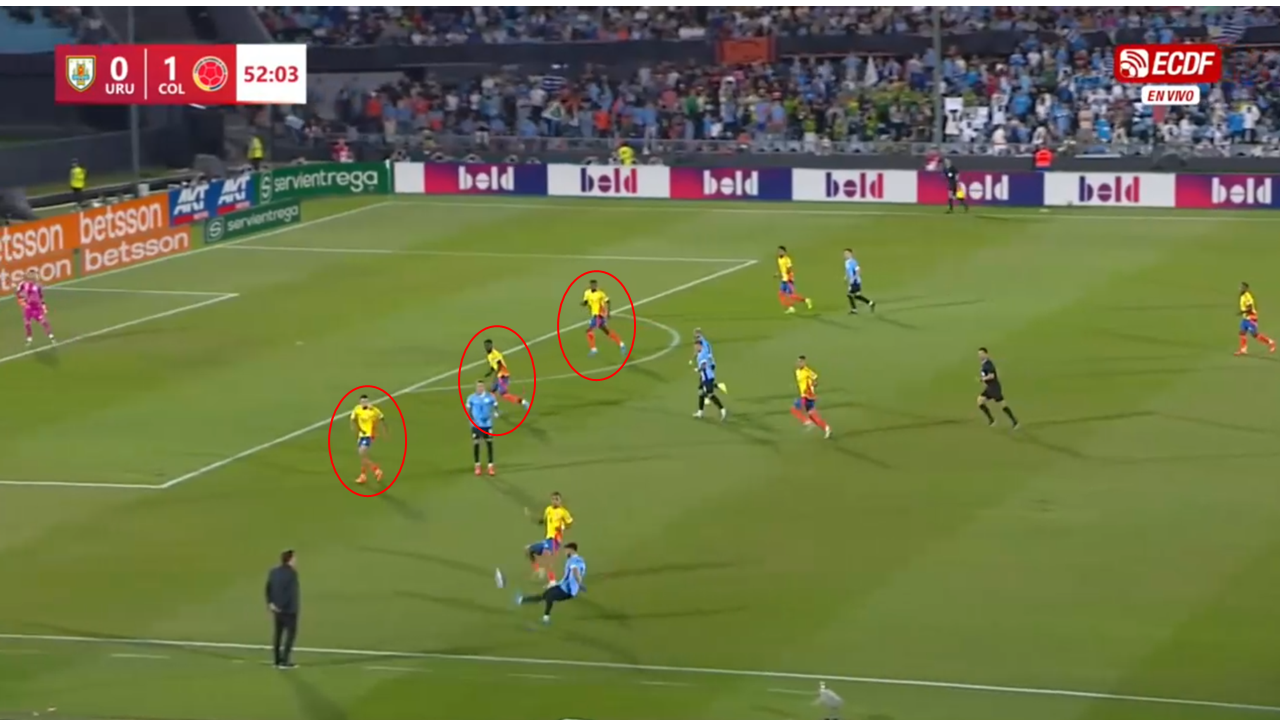
Colombia’s defence is set and ready to deal with the early cross.
The players are well positioned across the penalty area and stand on the half turn, ready to deal the cross if it’s played in behind the defence.
Colombia’s setup when defending crosses was structurally sound.
They ensured that players covered all the danger zones and had few gaps between them.

However, with the room that was given to Bielsa’s men on the flanks, it was only a matter of time before one of these crosses would pay dividends.
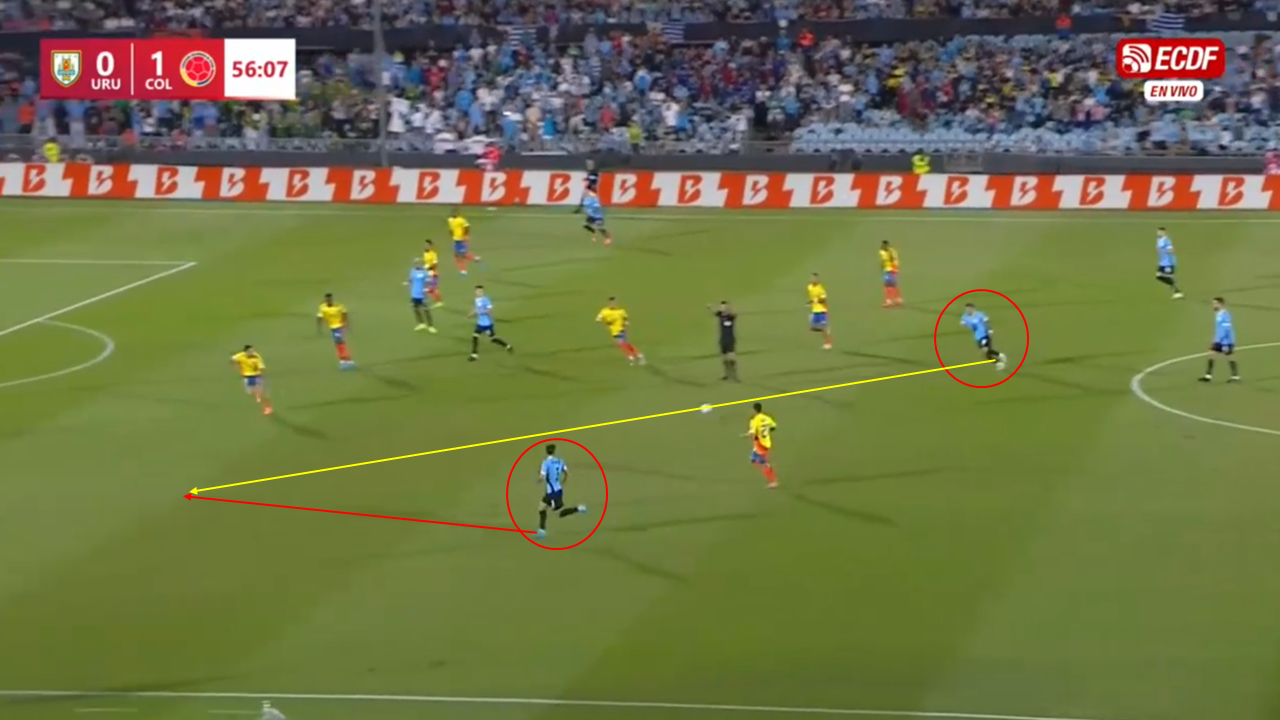
In this situation, Colombia’s right-back Muñoz has been dragged inside after several of Uruguay’s attackers made threatening runs in behind the defence during the initial phase of the attack.
This leaves acres of space on the flank. Boca Juniors’ Saracchi exploited this space and put a cross in the corridor of uncertainty, which was eventually deflected into Colombia’s net.
Not only did Uruguay manage to make the most of a 1v1 situation, but they also numerically outnumbered them.
This was possible because Colombia only had its full backs occupying the wide areas.
Uruguay would attack in twos and threes to get into dangerous positions.
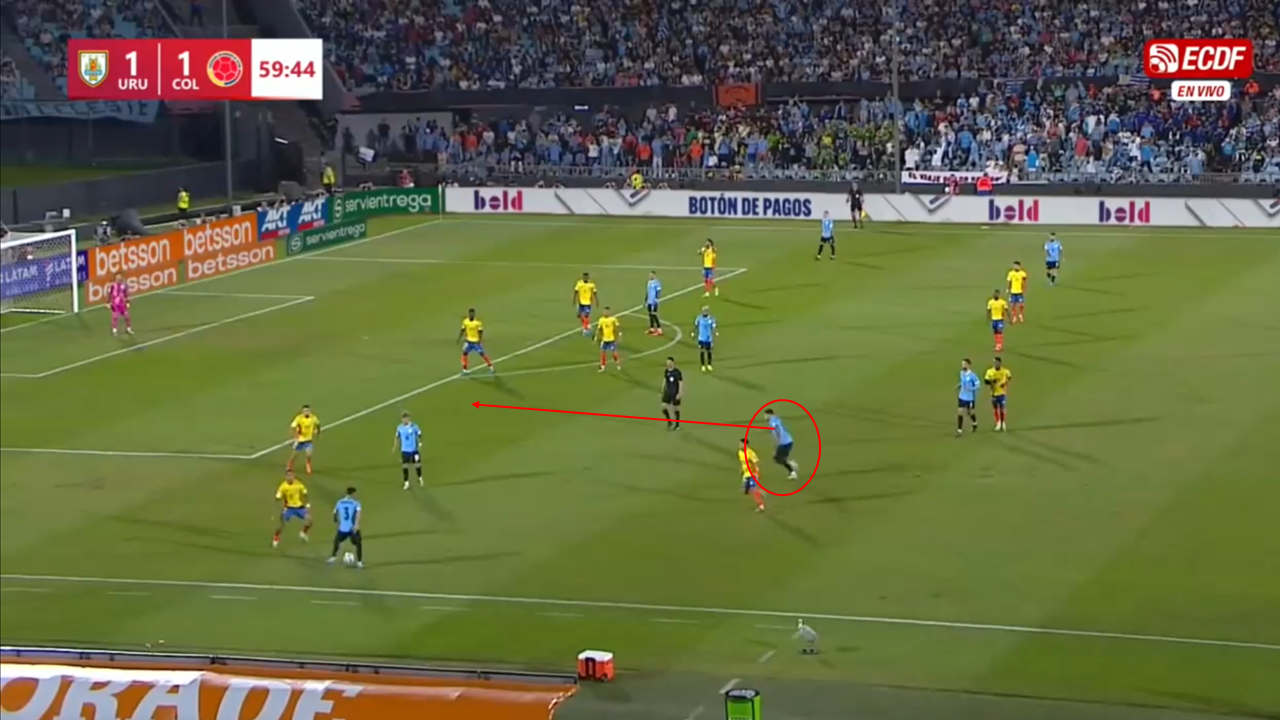
Again, on the left, a positive midfield run is made to create a 3v2.
This allows Uruguay to get into the box and eventually work the ball to Aguirre, who fires the ball into the bottom right corner.
Colombia’s setup demonstrated their tactical intentions.
They sought to play through the middle of the pitch, trying to utilise the four midfielders and two centre-forwards.
Colombia found moments of joy through aggressive forward runs.
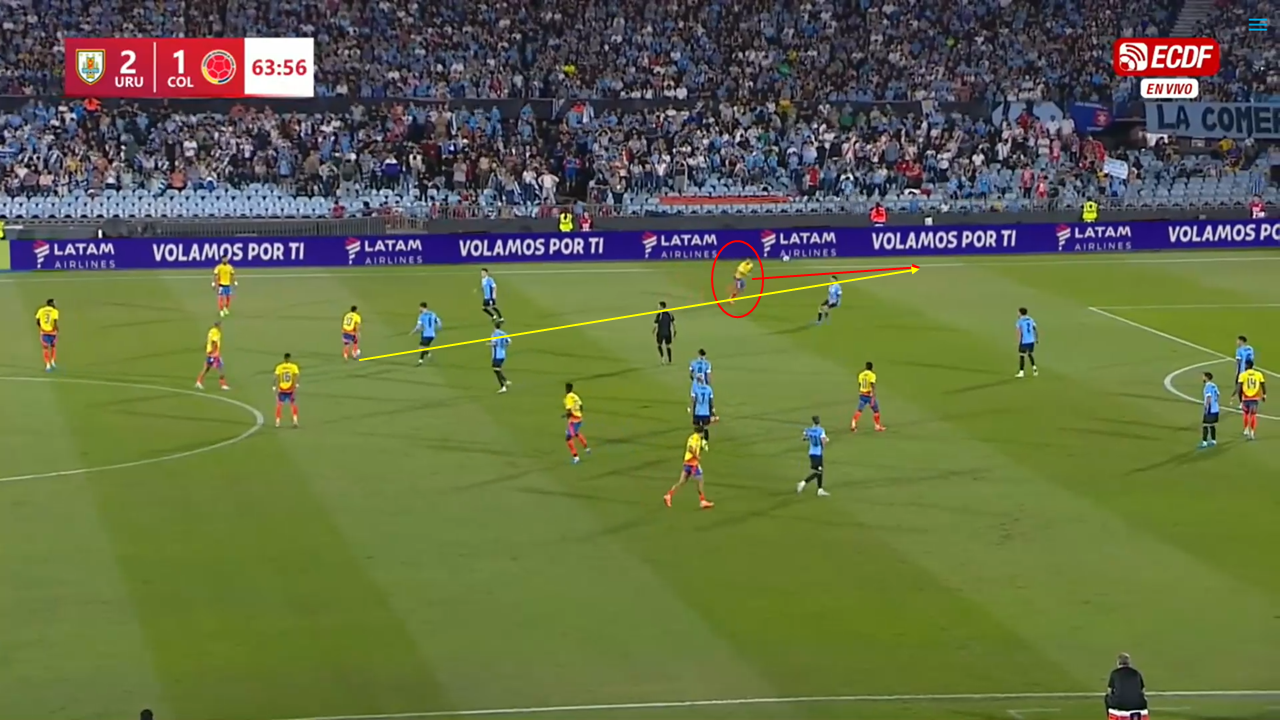
Here, Quintero finds a teammate who’s stretched the Uruguay defence and receives the ball in the final third.
Uruguay were equal to their attempts at penetrating the middle of the pitch.
Colombia sought to create opportunities to get in between the lines of Uruguay’s midfield and defence through opposing movements from their forwards.
As one attacker dropped deep, another darted in behind.
This type of movement often leaves gaps in the defensive line for the opposition to exploit.
Uruguay was ready for these types of movements, and Valverde and Bentacur played an essential role in stopping Colombia’s attacks.
The backline ensured they communicated clearly and passed on forwards, dropping into gaps.
A Missed Opportunity
Uruguay Vs Colombia’s High Regains Chart
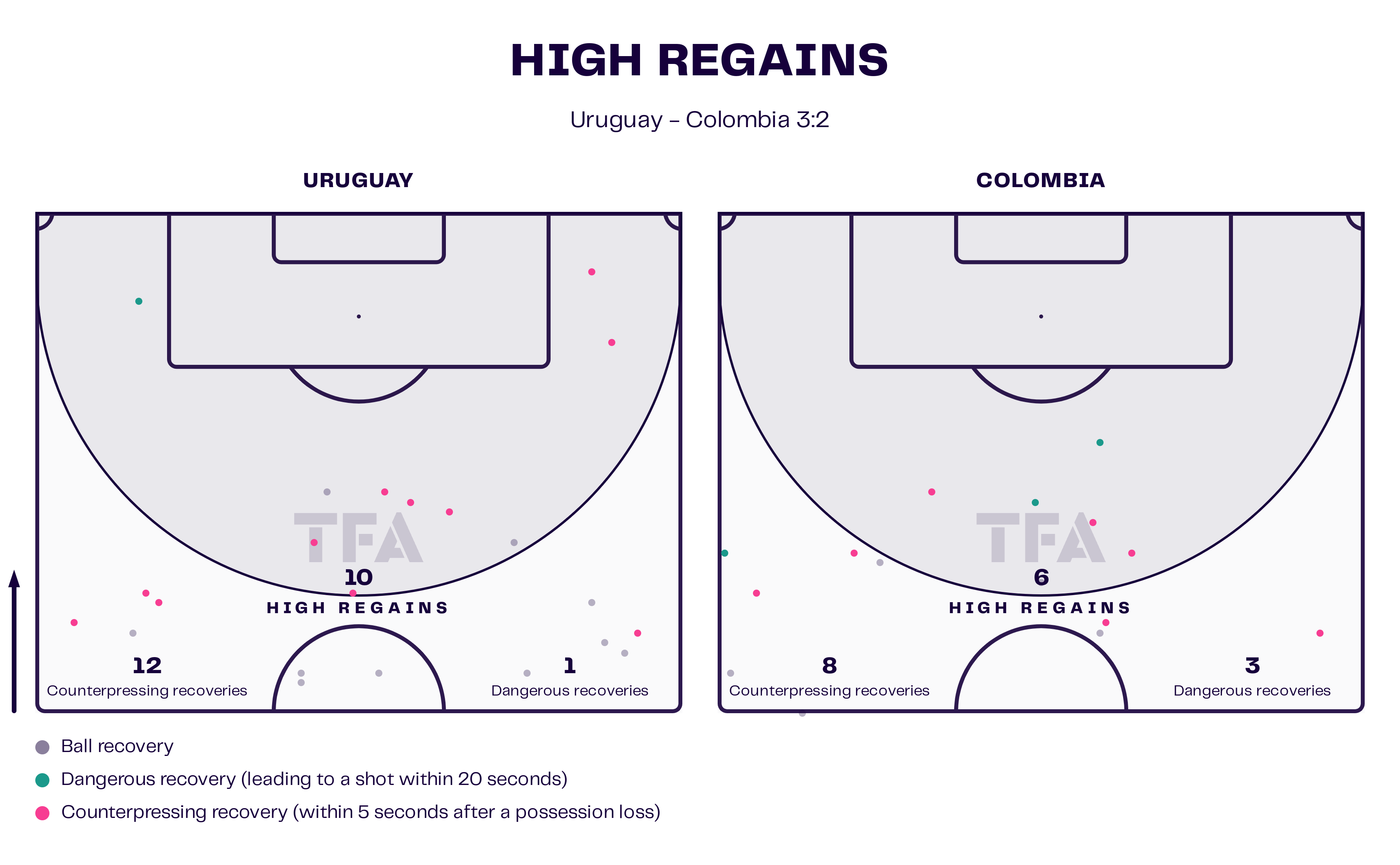
Colombia will feel they could have had more success and exploited Uruguay during their side’s attacking transition.
Both sides showed great reactions at times, winning the ball back quickly after having lost it and then playing forward quickly to commence the attack.
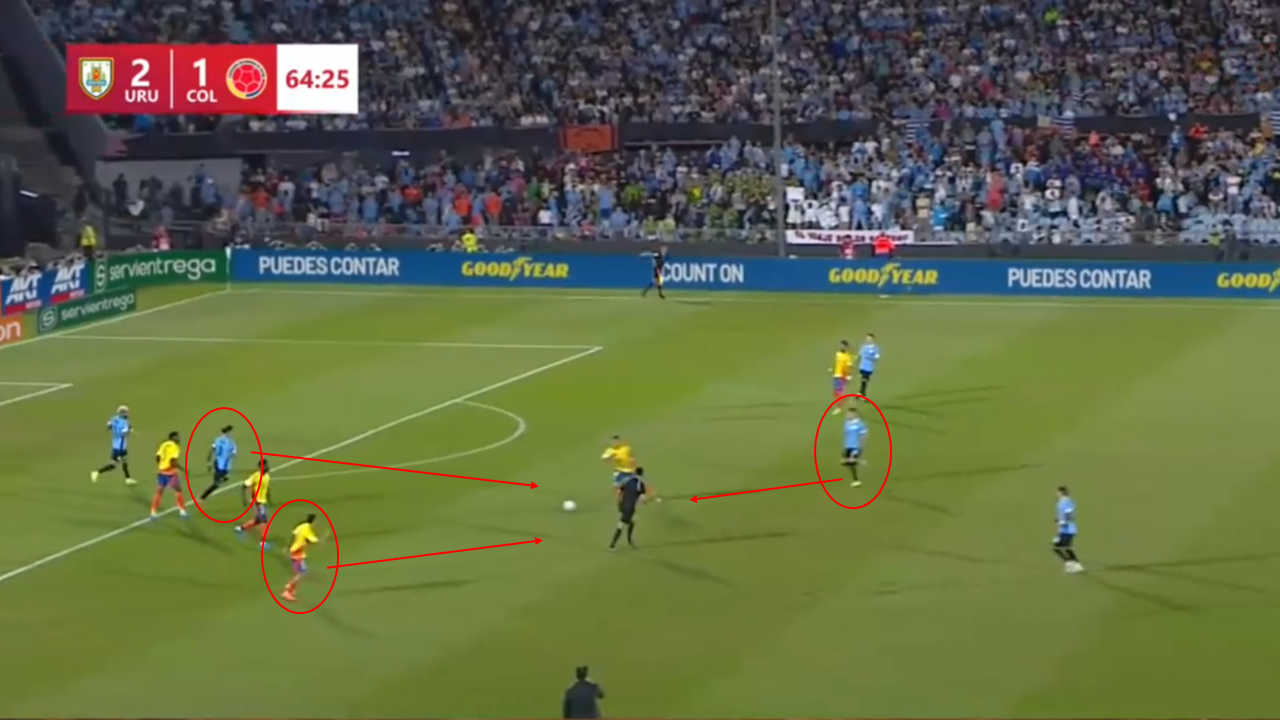
Here, as Uruguay lost the ball, they quickly reacted and effectively closed the space, not allowing Colombia to play their way out of trouble.
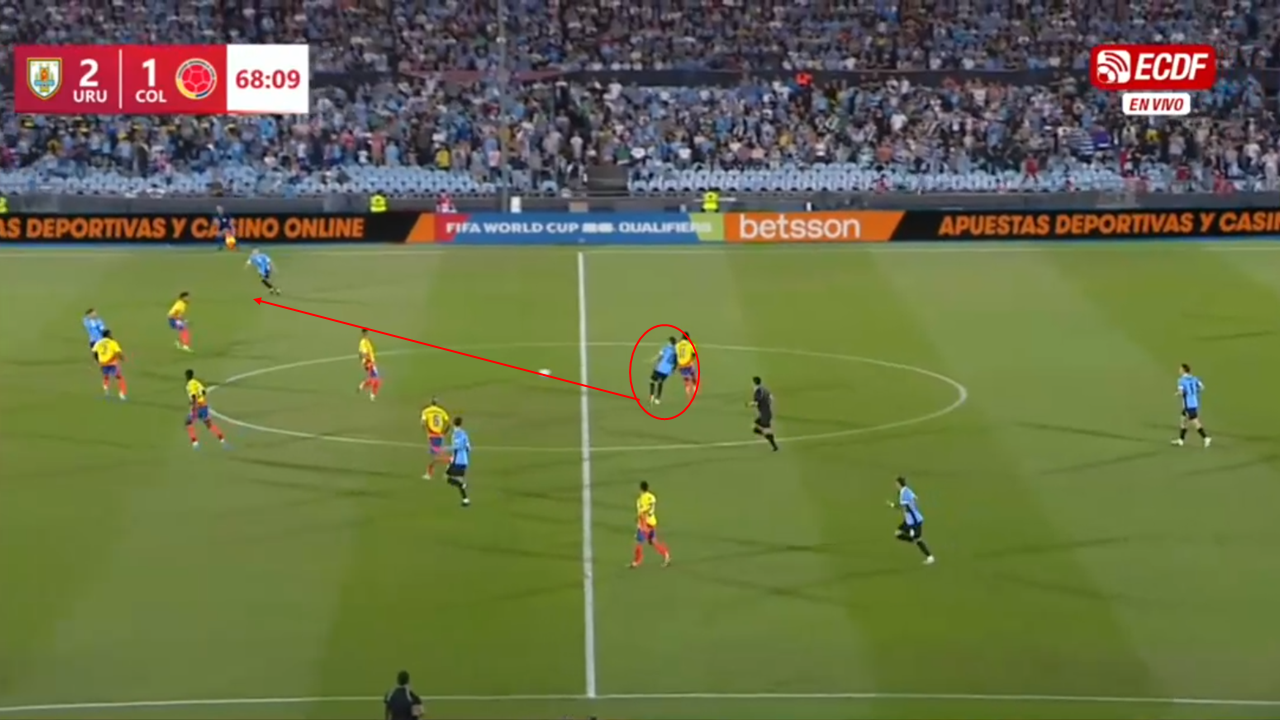
As seen here, Uruguay were also efficient at playing forward.
In this example, as soon as the ball broke loose in midfield, they quickly made forward runs to be an available option for a forward pass.
Colombia also had a very effective tactic in these situations.
They did brilliantly to spot when they could press Uruguay’s backline intensely.
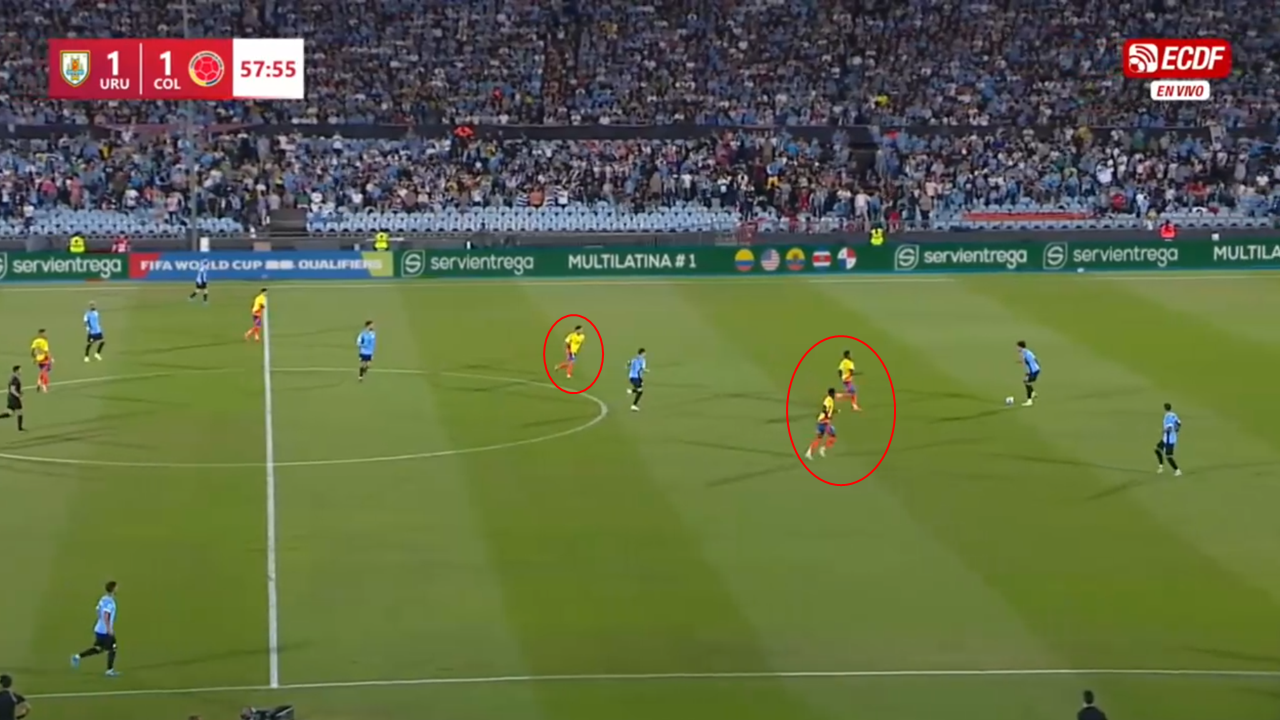
Here, as Uruguay regains possession and seeks to play out from the back, Colombia presses intensely, with their front three matching Uruguay’s deepest players numerically.
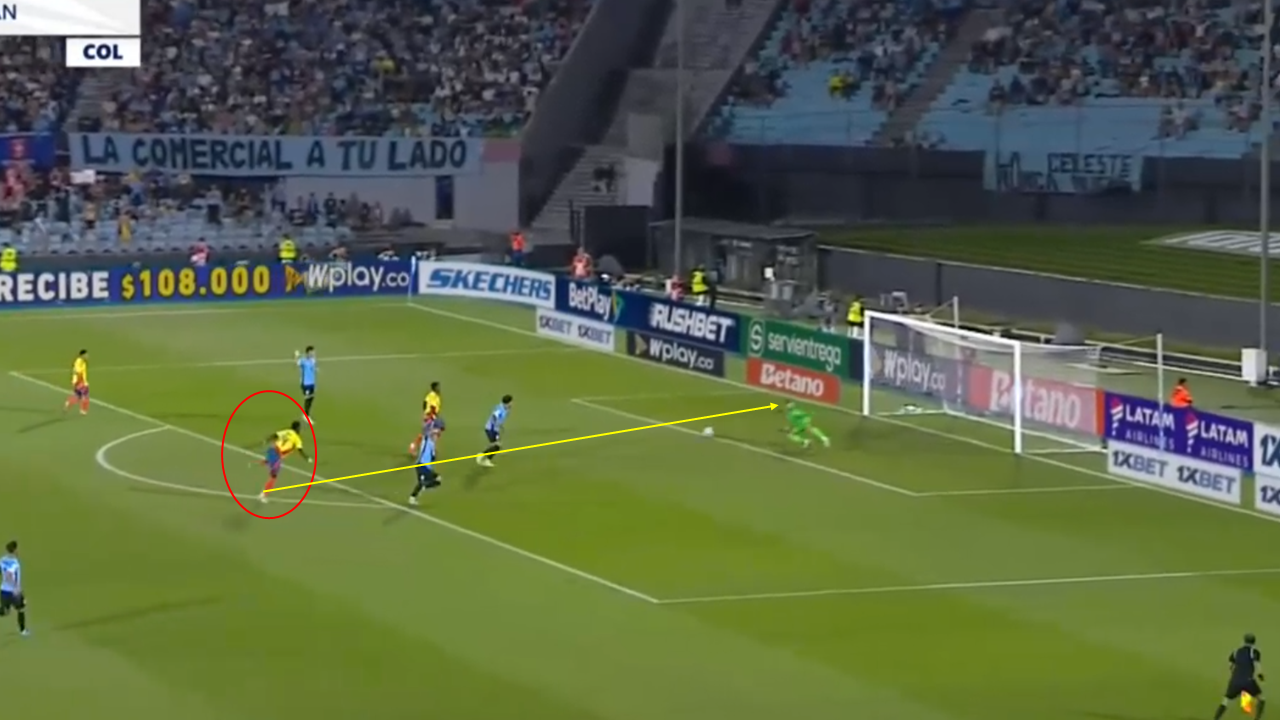
This leads to them winning the ball back.
However, disappointingly, Jhon Durán fires the ball tamely into the keeper’s arms, failing to take a golden opportunity.
Conclusion
Overall, Uruguay were definitely the better side on the night.
They will take great confidence from this performance and should qualify easily for the 2026 World Cup.
Colombia will be disappointed and need to find consistency again to make qualification as painless as possible.

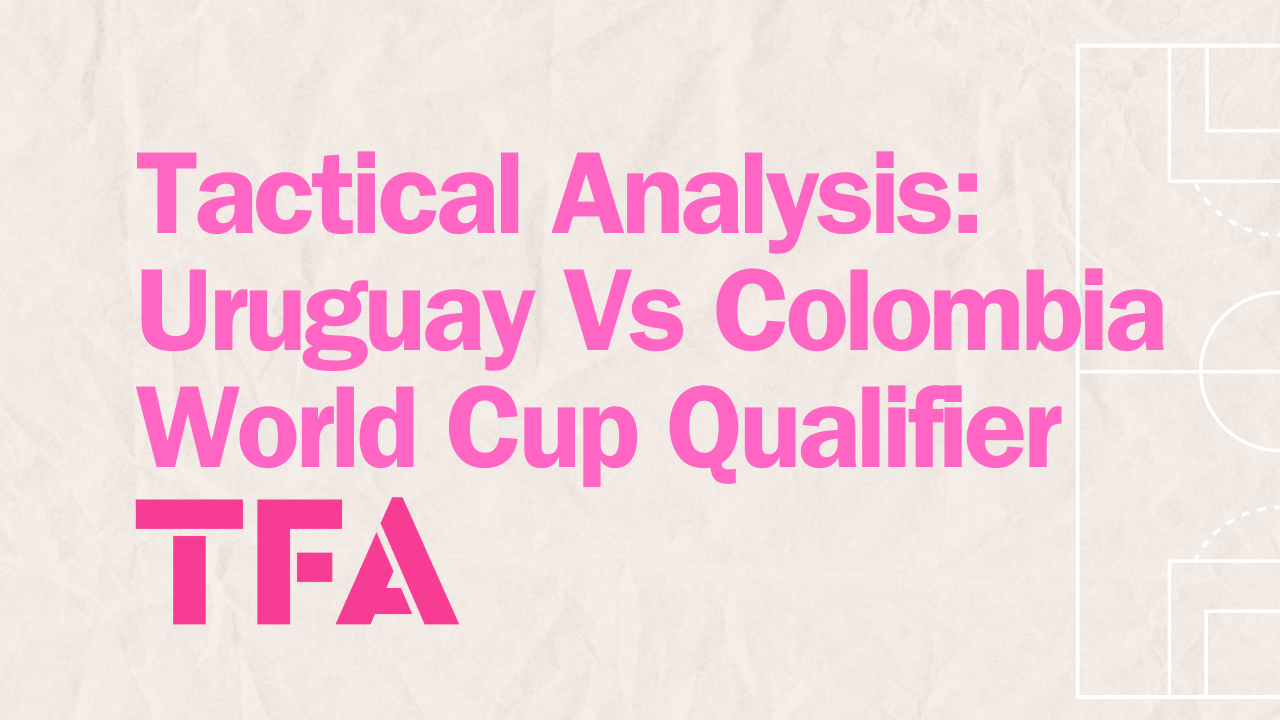



Comments